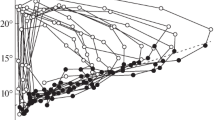Abstract
The distributions of sunspot longitude at first appearance and at disappearance display an east-west asymmetry that results from a reduction in visibility as one moves from disk centre to the limb. To first order, this is explicable in terms of simple geometrical foreshortening. However, the centre-to-limb visibility variation is much larger than that predicted by foreshortening. Sunspot visibility is also known to be affected by the Wilson effect: the apparent ‘dish’ shape of the sunspot photosphere caused by the temperature-dependent variation of the geometrical position of the τ=1 layer. In this article we investigate the role of the Wilson effect on the sunspot appearance distributions, deducing a mean depth for the umbral τ=1 layer of 500 – 1500 km. This is based on the comparison of observations of sunspot longitude distribution and Monte Carlo simulations of sunspot appearance using different models for spot growth rate, growth time and depth of Wilson depression.
Similar content being viewed by others
References
Baumann, I., Solanki, S.K.: 2005, Astron. Astrophys. 443, 1061.
Bogdan, T.J., Gilman, P.A., Lerche, I. Howard, R.: 1988, Astrophys. J. 327, 451.
Curto, J.J., Blanca, M., Martínez, E.: 2008, Solar Phys. 124.
Dalla, S., Fletcher, L., Walton, N.A.: 2008, Astron. Astrophys. 479, 1.
Dougherty, E.R., Astola, J.T.: 1994, An Introduction to Nonlinear Image Processing, SPIE Optical Engineering Press, Washington, 6.
Dougherty, E.R., Lotufo, R.A.: 2003, Hands-on Morphological Image Processing, SPIE Optical Engineering Press, Washington, 130.
Freeland, S.L., Handy, B.N.: 1998, Solar Phys. 182, 497.
Gokhale, M.H., Zwaan, C.: 1972, Solar Phys. 26, 52.
Howard, R.F.: 1992, Solar Phys. 137, 51.
Howard, R.F., Harvey, J.W., Forgach, S.: 1990, Solar Phys. 130, 295.
Marshall, S., Fletcher, L., Hough, K.: 2006, Astron. Astrophys. 457, 729.
Matheron, G.: 1975, Random Sets and Integral Geometry, Wiley, New York, 16.
Mathew, S.K., Solanki, S.K., Lagg, A., Collados, M., Borrero, J.M., Berdyugina, S.: 2004, Astron. Astrophys. 422, 693.
Maunder, A.S.D.: 1907, Mon. Not. Roy. Astron. Soc. 67, 451.
Minnaert, M.: 1939, Astron. Nachr. 269, 48.
Prokakis, T.: 1974, Solar Phys. 35, 105.
Roša, D., Brajša, R., Vršnak, B., Wöhl, H.: 1995, Solar Phys. 159, 393.
Scherrer, P.H., Bogart, R.S., Bush, R.I., Hoeksema, J.T., Kosovichev, A.G., Schou, J., et al.: 1995, Solar Phys. 162, 129.
Schuster, A.: 1911, Proc. Roy. Soc. London A 85, 309.
Serra, J.: 1982, Image Analysis and Mathematical Morphology, Academic Press, London, Chap. 1.
Solanki, S.K.: 2003, Astron. Astrophys. Rev. 11, 153.
Author information
Authors and Affiliations
Corresponding author
Rights and permissions
About this article
Cite this article
Watson, F., Fletcher, L., Dalla, S. et al. Modelling the Longitudinal Asymmetry in Sunspot Emergence: The Role of the Wilson Depression. Sol Phys 260, 5–19 (2009). https://doi.org/10.1007/s11207-009-9420-z
Received:
Accepted:
Published:
Issue Date:
DOI: https://doi.org/10.1007/s11207-009-9420-z




